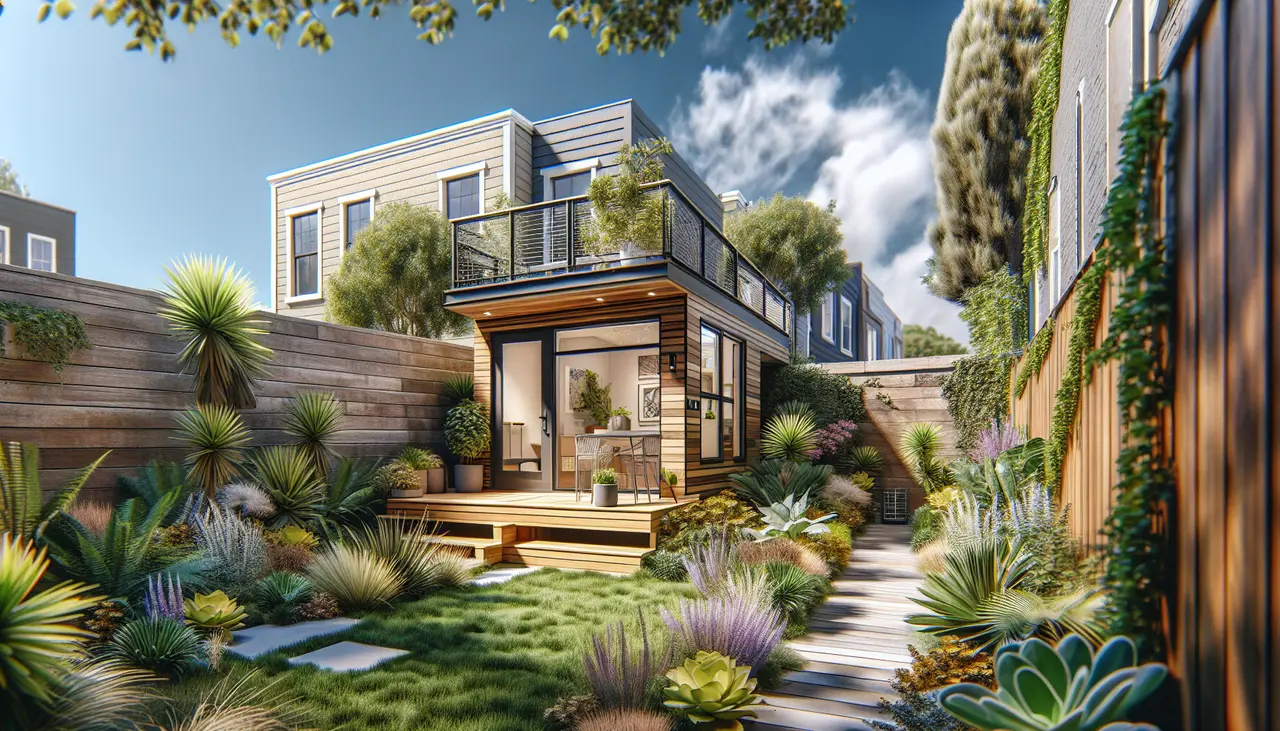Introduction to ADU: What It Means for Bay Area Homeowners
An ADU, or Accessory Dwelling Unit, is a game changer for Bay Area homeowners. Think of it as a mini-home in your backyard. It could be a converted garage, a tiny house on wheels, or a small apartment over your garage. For those in the Bay Area, where housing is both expensive and scarce, an ADU offers a brilliant solution to tackle space and financial challenges. Not only does it give homeowners extra space for family or guests, but it also opens up a unique opportunity to earn additional income through rent. With the Bay Area’s high rental demand, converting unused space into an ADU could be a smart move. Plus, it can increase your property value. So, embracing the ADU concept means not just making the most out of your property but also setting yourself up for financial gain.
Key Benefits of Building an ADU in Your Backyard
Building an ADU, or Accessory Dwelling Unit, in your backyard offers several sharp advantages, especially in the bustling Bay Area. First off, it’s a smart move for boosting your property value. Homes with ADUs tend to attract higher prices on the market, making it a solid investment. Secondly, it creates a new income stream. Renting out your ADU can bring in consistent cash, helping with mortgage payments or funding other endeavors. It’s not just about money, though. ADUs offer flexibility. They can serve as a home office, a space for aging parents, or a cozy spot for your returning college kids. Finally, considering the tight housing market in the Bay Area, adding an ADU is a direct contribution to easing the housing crunch. It’s a win-win, offering a private, comfortable living space while addressing broader housing needs.
Understanding the Legal Framework for ADUs in the Bay Area
Knowing the rules is key before you dive into turning your backyard into a cash machine with an Accessory Dwelling Unit (ADU). In the Bay Area, each city has its own set of guidelines, but California has laid out statewide regulations to make it easier. Here’s the deal: you’re generally allowed to build an ADU on your property if it’s meant for residential use. There are types like attached, detached, or even converting part of your existing home. Size and placement have rules too. Your ADU can’t just sprawl anywhere; it has boundaries, often dictated by property lines and specific zoning laws. Also, getting your plans approved is a must. This means showing your city officials what you want to build and how it meets all the guidelines. Don’t forget about permits. Before any work begins, you’ll need proper permits which vary in cost by city. It sounds like a lot, but understanding these basics can smooth the path towards boosting your property’s value and earning extra income. Remember, stay informed and follow the process; it pays off in the end.
Planning and Zoning Considerations for Your ADU Project
When diving into your ADU (Accessory Dwelling Unit) project in the Bay Area, understanding local planning and zoning laws is your first step. Cities have their own rules which dictate where and how you can build your ADU. These rules cover lot size, setbacks (how far your ADU needs to be from property lines), and height restrictions. It’s all about ensuring your ADU fits within the community while giving you room to maximize your space. Before setting your heart on a specific design or location for your ADU, check with your city’s planning department. They’ll let you know what’s allowed and what’s off-limits. This upfront homework can save you from headaches and costly changes down the line. Remember, getting your ADU off the ground isn’t just about the build—it’s making sure your dream pad plays by the rules.
Design Ideas and Inspiration for ADUs
When it comes to designing your ADU (Accessory Dwelling Unit), think functionality and comfort. The sky’s the limit, but let’s keep it grounded with practical tips. First up, consider a minimalist design. In small spaces, less is more. Choose furniture that doubles as storage and avoid clutter. Next, focus on natural light. Install large windows or skylights to make the space feel bigger and more inviting. Consider using mirrors to reflect light and create the illusion of more space. Now, let’s talk about the outside. Your ADU should blend with your main house but it can still have its own personality. Use similar materials or paint colors for a cohesive look. And don’t overlook the landscaping. A small patio or garden can connect the ADU to the environment, making it feel like a home. Lastly, think about future uses. A flexible design can adapt to changing needs, maybe a home office now and a rental unit later. Each choice you make should add value and function to your tiny backyard gem.
Calculating the Costs: Investment vs. Profit Potential
Building an Accessory Dwelling Unit (ADU) in your backyard is an upfront investment that can pay off big in the Bay Area’s competitive housing market. The cost to construct an ADU can swing widely, ranging from (100,000 to )400,000 or more. This big range depends on factors like size, whether it’s a ground-up construction or a conversion of an existing space, the quality of materials used, and specific local building codes and requirements. But, let’s not just focus on the sticker shock. When crunching the numbers, consider the profit potential. Rental income in the Bay Area can be substantial, with ADU rents often starting at $2,000 a month and climbing higher depending on the location and amenities. This means, despite the initial costs, your ADU could pay for itself in a few years, then continue to generate steady income. Also, adding an ADU increases your property value, a plus if you ever decide to sell. In the end, matching the upfront costs against the potential for rental income and increased home value shows the true potential of investing in an ADU. It’s not just about spending money; it’s about making your property work for you.
How to Finance Your ADU Construction in the Bay Area
Financing your ADU (Accessory Dwelling Unit) in the Bay Area might seem daunting, but don’t sweat it; there are viable options out there. Firstly, consider tapping into your home equity. A HELOC (Home Equity Line of Credit) lets you borrow money against the value of your home, often at a decent interest rate. Another route is a home improvement loan, which is unsecured, so it doesn’t put your home at risk. Some folks opt for personal savings, but given the costs, this might mean waiting longer to start your project. Don’t overlook state and local grants either; the Bay Area has programs aimed at encouraging ADU construction to ease housing shortages. Lastly, talk to your bank about a construction loan. These are short-term and can cover both the purchase of the land and the ADU build. Interest rates are usually higher, but it’s a solid option if you plan to rent out your ADU and start pulling in income quickly. Remember, rates and terms vary widely, so shop around and negotiate the best deal for your situation.
Navigating the Permit Process for a Hassle-Free Project
Navigating the permit process for an Accessory Dwelling Unit (ADU) in the Bay Area doesn’t have to be a headache. First off, know this: every city has its own set of rules. Checking in with your local planning department is step one. They’ll give you the lowdown on what’s allowed and what’s not. You’ll likely need to submit detailed plans of your ADU project, showing everything from how it looks to where it sits on your property. Expect to talk about the size, design, and even the utilities. After submission, patience is key. Review times can vary widely. If the city gives the thumbs up, you’re good to go. If not, they’ll tell you what needs to change. It sounds like a lot, but taking it step by step makes it manageable. And hey, once you’ve got that permit in hand, your project moves from dream to reality.
Finding the Right Contractors for Your ADU Development
When you’re ready to jump into building your Accessory Dwelling Unit (ADU) in the Bay Area, picking the right contractor is crucial. Not all builders have the experience or understanding needed for these specific projects. To start, get recommendations from friends or family who’ve gone through the process. Online reviews and local forums can also offer insights into who’s best for the job. Look for contractors with solid ADU or small housing project experience. Ask for their portfolio and check if they’re familiar with local zoning laws and building codes—it’s key for smooth approval and construction. Price quotes matter, but cheapest isn’t always best. Balance cost with quality and reputation. Remember, a reliable contractor will make the ADU journey much smoother.
Maximizing Your ADU’s Profitability: Renting Out Your Space
Renting out your ADU, or Accessory Dwelling Unit, in the Bay Area can be a real game-changer for homeowners. Here’s the straightforward scoop: ADUs are in demand. People love them for their convenience and privacy. By renting yours out, you tap into a growing market craving affordable living spaces. Let’s break it down – location is king. Being in the Bay Area, your ADU’s rental price can be pretty attractive due to the high cost of living. Before setting a price, check out what similar spaces are going for in your neighborhood. Keep your ADU in top shape to attract the best tenants and command a higher rent. Think about it, a well-maintained space with modern amenities? That’s a magnet for renters. Finally, understand the legal stuff. The Bay Area has rules about renting out ADUs. Getting familiar with these laws ensures you’re not just making a smart move but also a legal one. So, putting your ADU on the rental market? It’s not just about extra cash; it’s about smartly leveraging your property in a way that benefits you and meets a growing need in the community.






